Ken Lizzi's Blog, page 46
October 24, 2021
Lin Carter, Appendix N Supplemental

Rereading DMG’s Appendix N, I noted that the Lin Carter entry specified a single series. Now, I’ve read quite a bit of his stuff. I had plenty of fodder for my post on Mr. Carter. But I’d neglected the very work that got him enshrined in Appendix N. I was chagrined.
So, after a quick visit to Thriftbooks online, I ordered the first two of the World’s End series. I’ve read the first, Warrior of World’s End, and have plunged into the second, The Enchantress of World’s End. Will I purchase the rest? Read on and see.
As I’ve only read one installment, I’ll mostly limit my comments to it.
Warrior of World’s End features one of Carter’s super men and demigods as its lead. Ganelon Silvermane is cast from the same mold as Amalric the mangod (see Flashing Swords #1 and #3 ). These heroes are more Hercules than Conan, superhuman rather than merely human. The adventures are set in the far distant future, one in which the continents have once again blended into a single super-continent, Gondwane. The book seems to be the result of Carter binging on Jack Vance’s Dying Earth stories (though Cugel’s Saga and Rhialto the Marvelous hadn’t yet been published), while lying atop a bed of silver age comic books.
And it is delirious, silly fun. Carter has always been an excellent mimic, particularly of Lord Dunsany. Here he does a fine Vance, so long as that aspect holds his interest. The later chapters read as if Carter is making it up as he goes and having a delightful time doing so, only occasionally recalling that he began the story as an homage to Vance. There’s an everything and the kitchen sink feel about it, that I think is what drew Gygax to the series. Anything goes: mighty-thewed warriors, mechanical, anti-gravity powered sentient metal birds, aliens from Canopus, ghosts, floating islands with electronic, oxygen sucking death rays, all manner of quasi-, demi-, and pseudo-humans, lady knights clad in impractical yet sexy armor, extra-dimensional lobster creatures, etc. Gonzo stuff.
The second book seems to have dispensed with the Vance pastiche. No footnotes so far, though I’m only a few chapters in. But it promises much of the same popcorn fantasy adventure.
So, yes, I’m in for the duration. I’ll put in my order for the remaining books.
Speaking of ordering books, you might like to order one or more of my Semi-Autos and Sorcery series.
October 17, 2021
Roger Zelazny, Appendix N Supplemental

I’ve written about Roger Zelazny before in my sporadic Appendix N series of posts. My recent reading of the entirety of the Dilvish the Damned sequence of tales requires that I add this supplemental. Because Dilvish is worthy of the effort.
Now, the culmination of Dilvish’s saga (The Changing Land, 1981) postdates Appendix N, but I’m going to include it in my comments for the sake of completion.
Dilvish (nicknamed “The Damned” for reasons I’ll make plain momentarily) is the half-elven hero of Zelazny’s revenge cycle. The elf bit is never fully delved into. The difference between elf and human cultures, the history of Dilvish’s world, etc. did not seem to greatly interest Zelazny. The world building is incremental, a brick here, a brick there in each short story as Zelazny makes it up as he goes along. That’s fine. The foundation of the saga is the short story, after all. I rather doubt Zelazny had mapped it out when the first tale, Passage to Dilfar was published in 1964. Then again, perhaps he had. I merely speculate.
Dilvish is an aesthete, a reluctant military man, a man of honor, though not rigidly so. He runs afoul of the powerful sorcerer Jerelak. Jerelak transforms him into a statue and sends his soul to hell, where he endures a couple centuries of torment. The driving motivation behind the sequence of tales and the subsequent novel is Dilvish’s desire for revenge.
And within that rather standard character motivation Zelazny invests his stories with subtle themes and gradual shifting of perspective. I don’t know if he did so deliberately, but this plays out somewhat in the style of the narrative as well. The initial stories are mannered, framed in stilted language. But as Dilvish’s years of pursuit wear on and other characters begin to question his monomania, the language Zelazny employs shifts to a more contemporary mode, with the characters speaking in colloquial American English. It suggests, perhaps, a softening of purpose, a relaxation and a temptation to accommodate to the needs and desires of the moment. Dilvish is hardly above giving in to the desires of the moment.
The short stories bring Dilvish near to his revenge, leading to a damaged and weakened Jerelak, who manages to escape. The novel takes place at a location mentioned near the end of the stories. Interestingly, Dilvish becomes one of many POV characters, all with differing objectives. The culmination turns out to be more the final development of Dilvish’s attitude toward revenge than the demise of Jerelak. It is interesting and well done, though in the hands of a lesser writer it might have come across as disappointing or anti-climactic.
The same praise can be made with regard to Dilvish as a character. He is well drawn and interesting. But Zelazny provides him with crutches, in the form of his steed Black (a powerful spirit or perhaps demigod, usually taking the guise of a metallic horse-like creature), his elf boots, and (early on) a magic sword. He gets out of scrapes by way of these aids rather than by his own wiit, skill, or stratagems. There is something more of the European fairytale to this rather than American Swords and Sorcery. But again, thanks to Zelazny’s skill, it works. The amusing conversations between Dilvish and Black help. And help delineate Dilvish’s character. Black if cautious and pragmatic. Dilvish is chivalrous, if not quixotic, bordering on reckless. Black is always there to help pull Dilvish out of the predicament his curiosity gets him into. Zelazny is wise enough to write the occasional bit in which Dilvish aids Black, showing us that their relationship is a partnership.
I’ve enjoyed reading the odd Dilvish story here and there. But reading through the entirety in sequence helped me appreciate them even more. I assume Gary Gygax was familiar with at least some of the stories. The Elven Boots magic item in the Dungeon Master’s Guide might well have been inspired by Dilvish. I can see the adventures Dilvish gets entangled in being influential. In summary, good stuff.
If you’d like to read some other good stuff, may I recommend my series Semi-Autos and Sorcery, published by Aethon Books? They are pulp-influenced, contemporary fantasy adventures. Check them out and let me know what you think.
October 10, 2021
Columbus Day Fiction

MBW, the HA, and I hosted a Columbus Day party yesterday. We served homemade limoncello, and I tapped a keg of homebrew. We nibbled on vaguely Italian themed snacks. I put on a quiet Dean Martin and Frank Sinatra soundtrack for the affair. And today I find myself thinking about fantasy and science fiction linked to the New World. That’s just the way my mind works.
The recently departed L. Neil Smith penned a thoroughly original novel speculating on an Aztec empire that was able to grow as a result of the Black Death proving more lethal in this alternate timeline than in ours. It’s a compelling adventure novel that I’ve read a couple of times.

I remember reading an S.P. Somtow novel in which Rome had never fallen. I recall it being rather humorous. The hero, a Roman official, is a native Senator from Terra Novo. So it’s Romans meeting Aztecs. And, I think, Bigfoot. A quick Bing search yields the title: The Aquiliad.
Switching to Swords and Sorcery, there are a few appropriate stories that spring to mind. H.G. Wells (yes, that H.G. Wells) wrote an S&S yarn set in the New World. I reviewed it here.
Alan Dean Foster wrote of Incas and Conquistadors in a story I reviewed here. (Rex Stout — yes, the Nero Wolfe Rex Stout — wrote a lost world novel featuring Incas, but as it is set in the early Twentieth Century I don’t think it quite fits my hastily invented, rather nebulous category.)
Even more to my taste was the partial REH story, completed by Andrew Offutt that I reviewed here. For a short story, it packed in a lot. In the person of the lead character — the conquistador — is contained much of the contradictions involved in mankind’s history of exploration and conquest: the almost unbelievable will to push on, bravery, greed, curiosity, adaptability, innovation, and treachery. The admirable and the deplorable.
Do you have any appropriate Columbus Day stories to suggest? If you’d like an entirely unrelated suggestion, how about my second novel? Under Strange Suns might be the science-fiction/planetary romance novel you didn’t know you wanted to read.
October 3, 2021
Crossover Appeal

The Lord of the Rings achieved popular acclaim long before Peter Jackson even conceived of filming the work. LOTR appeals to mass readers, not only to niche genre aficionados. Its presence is felt worldwide, even beyond the pages of fiction, influencing the development of everything from video games to political sloganeering. The books continue to be printed, new editions appearing all the time.
Will any other work of fantasy fiction ever manage anything near such universal crossover appeal? Does it matter? I suppose not. My appreciation of something is not dependent upon its popularity. Still, the question occurred to me.
The Song of Ice and Fire enjoyed a several year run of popularity through HBO’s Game of Thrones series. But will that popularity carry over to decades of continuing book sales? It is probably too early to say, and may depend on whether or not Mr. Martin ever completes his work. And how much of the popularity can be credited almost entirely to HBO? Was Tyrion Lannister a household name prior to the show? Frodo was, decades prior to Elijah Wood portraying the character. I suppose we’ll see.
Conan will endure as an icon, much the same as Sherlock Holmes. The films and comics ensure his immortality. But will the stories reach a mass audience? Does anyone outside of a core fanbase (that includes myself, naturally) read REH? Or will Conan’s popularity continue to be confined to adaptations in other media?
I’m discounting Harry Potter, since my question is limited to adult fiction. But, will even HP endure? Or was it a generational phenomenon?
Perhaps there is some book on the horizon that will break through. I remain skeptical, however. Any ideas, readers?
If you want to help me give mass popularity a shot, take a look at these offerings and read one (or more) of them.
September 26, 2021
Literary S&S on Film

We are awash in fantasy films. Even Sword-and-Sorcery has a sizable number of entries (though generally of rather dubious quality.) Yet few of the S&S entries are adaptations of literary works. Why is that? There is no shortage of quality material to mine. Perhaps the producers determined it was cheaper to create a new property rather than license an existing one, thinking all you need is some muscular actor, a sword, a few scantily clad vixens, a malevolent, moustache twirling villain, some cheap, faux-medieval backdrops, and the script will essentially write itself.
How has that worked for them?
Still, how has the alternative worked? How many adaptations of literary S&S do we have for comparison? Let me see what I can remember.
We have, of course, the obvious example. Conan the Barbarian. As a faithful adaptation it comes up short, but it is nonetheless clearly connected to the source material. Of the sequel, the less said the better. I could almost say the same about the remake. The financing was there, Jason Mamoa was inspired casting; he could provide both the mirth and the melancholy, and physically he was a reasonable choice. It’s a pity that for the size of the budget, the producers couldn’t afford a script worth a damn. A wasted opportunity to reinvigorate the franchise.
I’ve stated before that I consider Sword and Planet close enough kin to S&S to qualify. So I can count John Carter. The story deviates from the first Barsoom novel, but it adheres to the source material more faithfully than did the Schwarzenegger vehicle. The film was a box-office disappointment, but I wasn’t disappointed. I enjoyed the flick.
If we’re counting Sword and Planet then I suppose I have to mention the Gor movies. Not even Jack Palance could save these turkeys. I’m afraid I couldn’t sit through either. So I can’t speak as to how faithful they are. In fact, even if I had watched them, I probably couldn’t give an informed opinion. I read two or three of the books in college, but recall very little about them.
I don’t think Sinbad qualifies. The Thousand and One Nights really isn’t S&S, so none of those fun movies get in, nor any of the Ray Harryhausen-powered Greek myth fantasies.
The King Arthur myths are a genre in their own right. Not S&S, so none of those adaptations fit here. LOTR is epic fantasy. The Princess Bride is comic high fantasy.
The Witcher, I think we can give a pass to, as the series was, in a sense, one long film. And the lineage of Geralt of Rivia as an S&S character by way of a certain albino Melnibonéan is, I think, understood.
Am I missing any? Not a great sample size, I suppose. But I think, setting aside the Gor films, we can see a clear superiority to the fare not derived from literary S&S, e.g., The Sword and the Sorceress, Ator, etc. (I wonder if a case could be made for The Warrior and Sorceress. It is yet another version of Dashiel Hammett’s The Glass Key, variously filmed as Yojimbo, A Fistful of Dollars, Last Man Standing, and probably others I can’t recall. So this moderately entertaining David Carradine S&S movie does have a literary antecedent. But since the book in question isn’t S&S, I’d have to rule against it.)
Literary adaptations for the win. Especially John Carter and Conan the Barbarian. The former since it is a relatively faithful take on the original and the latter because it is a damn good film.Why is this on my mind? Well, I’m glad you asked. I’ve had brushes with adaptations of my own work. My short story Trustworthy was adapted as a student film. It was fun to read the script and see the finished product, pondering what was required to move from page to screen. But of more immediate interest is that my new series of novels, Semi-Autos and Sorcery, was picked up by a producer and is being shopped around Hollywood. Now, this sort of thing happens frequently and most often nothing comes of it. I haven’t broken out the abacus to begin counting my chickens. But it is fun to speculate on. If you’ve read any of the books, do you have casting opinions? What about format: films, mini-series, animation? And, if you haven’t read any of the books, why not give them a try?
September 19, 2021
S&S & Appendix N
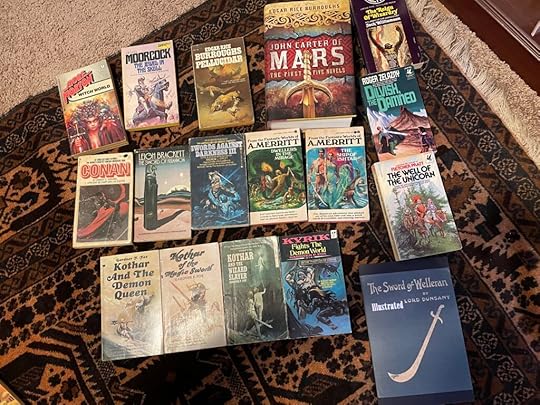 Yes?
Yes?Appendix N to the Dungeon Master’s Guide is an ever full well. Each dip of the bucket brings up something thirst quenching. Gary Gygax’s pulp influences were as broad as they were deep. Some feel that D&D is best seen as an immersive plumbing of pulp Sword and Sorcery. There is probably much to support that opinion. But even a cursory reading of Appendix N indicates that he did not limit himself to the sub-genre. He mined science fiction, historical fiction, and epic fantasy.
 No?
No?If, however, we want to investigate the S&S roots, we’d need to filter out anything extraneous. So, let’s sift through Appendix N and see what remains.
The introductory paragraphs to Appendix N are suggestive, and much can be surmised from them. But for the purposes of this post, I’m limiting the field to the itemized authors/titles.
He starts off with a bang. Poul Anderson gets three titles mentioned. Shall we quibble as to whether some or all of them are high fantasy rather than S&S? Sure, why not have at it? Let’s say the stakes are too high and the main characters insufficiently motivated by personal gain. I’m open to persuasion, but let’s say this isn’t S&S. Now, if Anderson got an et al, I could make a good case for him. But, Gygax did not. So I won’t.
John Bellairs Face in the Frost is a delightfully whimsical — and occasionally disturbingly horrific — fantasy. Not S&S.
Leigh Brackett gets the nod, I think since the line between S&S and Sword and Planet is nebulous to the point of non-existence. So, such works as The Sword of Rhianon I consider to constitute part of the S&S rootball of D&D.
Frederic Brown was a prolific and gifted SF and crime fiction writer. Not S&S.
Edgar Rice Burroughs gets credited for three distinct series. The Sword and Planet rule can be invoked again, and Pellucidar is an example of the Lost World genre. What think you: Do Lost World tales count as S&S? There is an outré element that borders on supernatural in that any science fiction veneer is so thin that it might as well be fantasy. The motives are usually survival (often instigated by cupidity.) I can see an argument for it. The Venus stories are, perhaps, closer to SF than are the Barsoom tales. But I think we can give ERB the S&S nod for John Carter, the immortal gentleman from Mars, by way of Virginia.
Lin Carter. World’s End series. You know what? I was already to give Carter an instant pass, thinking of his Thongor stories, which are clearly pulp S&S in conception (and, I think, execution.) But the thing is, I’ve never read any of the World’s End books. This is the series Gygax mentions and no others. Can anyone chime in? S&S or not?
L. Sprague de Camp gets a laundry list. One is a time travel book; his Sword and Planet Viagens Interplanetarias series gets no mention at all; and the Harold Shea stories and The Carnelian Cube (co-written with Fletcher Pratt) aren’t S&S. The Fallible Fiend books perhaps qualify, though as usual, de Camp is marching to the beat of his own drummer. Not everyone likes his particular syncopation. I do (and, apparently so did Mr. Gygax.) You might notice the absence of The Tritonian Ring or any of the other related Pusadian books, which de Camp deliberately wrote as his contribution to heroic fantasy. Interesting absence.
August Derleth. No titles mentioned. I’m assuming the Solar Pons books weren’t a D&D influence. So, it’s the Lovecraftian element. And so, not S&S.
Lord Dunsany. Again, no titles. I don’t think the King of Elfland’s Daughter qualifies. But such stories as The Hoard of the Gibbelins and, perhaps, one or two of the stories printed in The Sword Welleran qualify. (I’ve considered much of the material I’m discussing here previously, but I’m too lazy to link to all of the relevant web log posts.) So, yes, S&S.
Philip Jose Farmer gets a title and an et al. We can cast a broad net, then. A prolific pulp-influenced writer like Farmer can’t help but have at least dabbled in S&S. I’d give it to him for the Opar novels at a bare minimum. His contribution to Thieve’s Word, alas, can’t be counted due to chronological impossibility. I don’t think I’d consider the World of Tiers books to qualify, but I think we can count Farmer in the S&S column.
Gardner Fox. Kothar and Kyrik. Check and check. Unquestionably. Fox was leaning into the S&S.
REH. Conan. Drinking direct from the S&S hose here.
Sterling Lanier. Post apocalyptic SF. Fantastic stuff, but not S&S.
Fritz Leiber. Fafhrd and the Gray Mouser, et al. What, I wonder, did Gygax have in mind with the et al.? Clearly the man who coined the term Sword and Sorcery and who gave us two of its iconic heroes qualifies as S&S. But Leiber otherwise was mostly known for SF and some weird tales. So, probably some of that, such as Gather, Darkness. Like de Camp, Leiber influenced Gygax through multiple genres.
H.P. Lovecraft. No titles. But again, I don’t think there’s much doubt what Gygax had in mind here. Not S&S.
Abraham Merritt. (I wanted to type A. Merritt, but my computer, which thinks it knows better than I do what I intend to write, keeps tabbing over every time I write it and I don’t feel like figuring out the formatting issue.) Merritt gets multiple titles and an et al. Oddly, Ship of Ishtar isn’t one of them but perhaps gets in under et al. Moon Pool raises the Lost World issue again. But in this case, I’d say the evidence weighs against it’s admission as S&S. Dwellers in the Mirage, however, I’d say qualifies.
Michael Moorcock gets a few of the Eternal Champion novels mentioned. And the first three books of the Hawkmoon series are called out. Interestingly the Hawkmoon books use a far future, quasi-post-apocalyptic setting. But that’s quibbling. They are clearly as S&S as any Elric story, and it is trite at this point to mention that until rather recently neither writers nor publishers felt any compunction against freely mixing fantasy and SF elements. Anyway, S&S yes.
Andre Norton. No titles. But I assume Witch World was on Gygax’s mind with this pick. Witch World rather defies categorization, encompassing SF, portal fantasy, epic fantasy, horror, etc. But I think, with such Witch World stories as the Toads of Grimmerdale, Norton gets her Appendix N S&S spurs.
Andrew Offutt, as editor of Swords Against Darkness III. Why only this volume, I couldn’t say. But there can be no doubt of his S&S bona fides with this one.
Fletcher Pratt. Blue Star, et al. As I mentioned in regard to his collaborations with L. Sprague de Camp, I don’t consider the wonderful Harold Sheas stories to be S&S. Blue Star is too much of a political novel and intellectual exercise for me to consider it S&S. But the terrific novel The Well of the Unicorn? Sure, I can see that. One might take the position that it is an epic fantasy. And I can see that as well. So, being on the fence, I’ll go with not S&S.
Fred Saberhagen, Changeling Earth, et al. As with Pratt, I’m uncertain here. The Changeling Earth (The Empire of the East) books are must-read. But there is the post-apocalyptic aspect to consider and the suggestion that the stakes might be too high for proper S&S. There is the et al. to consider, but other than the Berserker stories and the Book of Swords series, I’m not well enough versed to opine on the et al. I can easily see how The Empire of the East influenced Gygax, but not from a purist S&S angle.
Margaret St. Clair. The Shadow People and Sign of the Labrys. I’ve read both. Not S&S.
J.R.R. Tolkien. The Hobbit, Ring Trilogy. Certain classical elements of the D&D adventure can be found adumbrated in The Hobbit. But I don’t think there is much room to dispute the statement “Not S&S.”
Jack Vance. The Eyes of the Overworld, The Dying Earth, et al. While The Dying Earth stories are set in the unbelievably far future, it is hard to argue that they are SF. On rare occasions a bit of technology makes an appearance, but for the most part the fantastic elements are magical. The characters are almost stereotypically driven by avarice and the main chance. I won’t say this is a slam dunk on par with the classification of, say, Conan. But it’s at least an easy layup.
Stanley Weinbaum. Cerebral, inventive SF. Not S&S.
Manly Wade Wellman. No titles, but for the Kardios of Atlantis stories, Wellman has to be given the nod. (I hadn’t properly appreciated, or remembered, the Kardios stories when I wrote my Appendix N entry on Wellman. For this I apologize to anyone who cares.)
Jack Williamson. No title. I think we are in de Camp and Farmer territory again. I’d say Reign of Wizardry is S&S, but Gygax might have been just as influenced by the pulp SF of The Legion of Space. But, yes, S&S.
Roger Zelazny. Jack of Shadows, Amber series, et al. Certainly the Dilvish the Damned stories get Zelazny in, even if you want to argue about the status of much of his other work.
So, what can we glean from this? There are twenty-eight authors listed in Appendix N. Of these, perhaps sixteen, just over half, arguably wrote sword and sorcery. That’s at least grounds to argue that the game itself does tilt toward an S&S foundation. It also reinforces the fact that Gygax’s influences were hardly limited to S&S, given that almost half of Appendix N roster consists of authors who did not write S&S and those that did often were multi-genre writers. I’d say that, even limiting ourselves to this provisional list of S&S writers, we can presume that Gygax wasn’t a purist, not beholden to labels. And I think that’s an admirable attitude. Trying to shoehorn something into a genre is limiting and stultifying.
If you need a lesson from this: read what you like.
Might I suggest you try my new series Semi-Autos and Sorcery, which I announced a few weeks ago? Books one and two are out, while book three is available for pre-order. I’d like to promote my earlier works more often, but it is customary to push the current releases, so I’ll follow the beaten path. (But you can browse for yourself here, if you’d like.) Remember, reviews are gold. I’d love to hear what you think about my stories, good, bad, or “meh.” (On second thought, limiting feedback to “good” would be preferable. Yeah, let’s stick with good. Who’s got the time for negativity?)
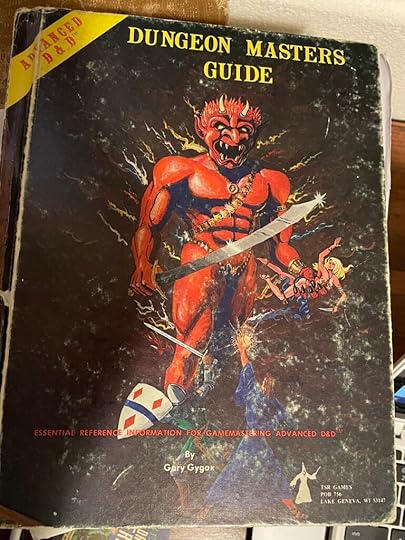
September 12, 2021
A Day for Reflection

September the Eleventh is, perhaps, a better day than most for reflection. Falling on a Saturday, yesterday, it also offered one of the last fine summer days of the year. For both reasons I took MBW and the HA out into the hinterlands, into the foothills of Mt. Hood.
The original destination was Lost Lake. As the roads mapped out for us by Apple Maps and Google Maps slowly diminished to rutted gravel roads and finally terminated at a locked gate with a “Trail Closed” sign, we opted instead for Frog Lake.

Kayaking was always intended. But I’m not here to dwell on would haves, could haves, and should haves. Instead, let’s just take a moment to reflect upon a lake that’s doing its best to reflect as well. Pretty, isn’t it?

This web log is not the proper place for me to express my thoughts on the events of twenty years ago. So, I won’t. We’ve all had plenty of time to ponder, we all know what we think, and are familiar with the emotions that memories of that day bring. So, I’ll keep mine to myself. At least here, in this venue.
Instead, I’ll just offer you these pictures. And, since I’m an unabashed money grubber, let me remind you that the first two books of Semi-Autos and Sorcery are available here and here, with the third only weeks away.


September 5, 2021
The Illustrated Solomon Kane

While most of us are familiar with the black and white Conan comic Savage Sword of Conan, perhaps not all are aware that the magazine also included Solomon Kane stories. A role call of great illustrators penciled and inked the Conan stories: John Buscema, Gil Kane, Barry Windsor Smith, Alfredo Alcala, Ernie Chan, etc. Terrific stuff.
The undeniable reality is that Solomon Kane was served by the B-Team. Not that the art was bad, but for the most part it doesn’t compare favorably with the Conan work. Still, it is worth checking out. Let’s take a look, shall we.
Consider first Ralph Reese, illustrating Skulls in the Stars. It isn’t bad. There is just something broad and big foot about it. Serviceable, but not up to the standards set by the Conan artists.
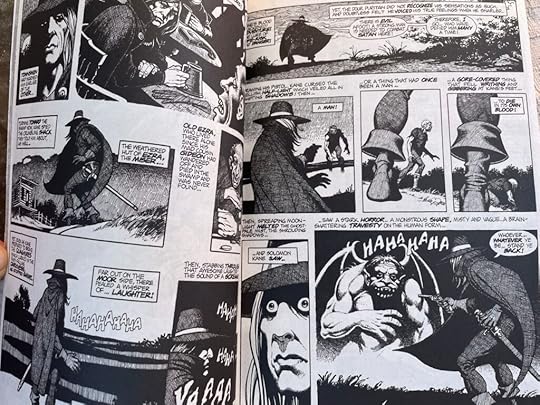
The team of artists in the Kane meets Dracula story does, I think you’ll agree, a better job. Alan Weiss, without the backup team, tackles The Hills of the Dead. His lean-limbed Kane and the solid inking work providing depth and shadow does more credit to Kane. Pablo Marco’s inking of Weiss in Into the Silent City is, I think, a step back.
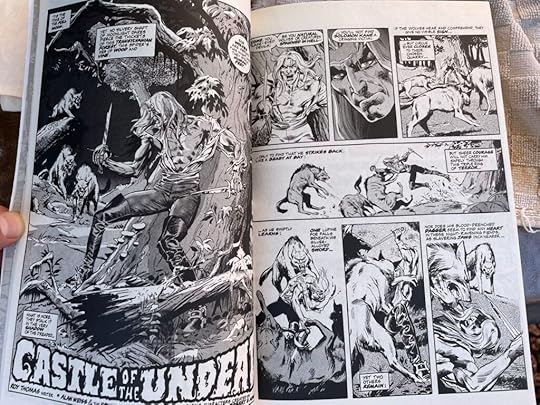
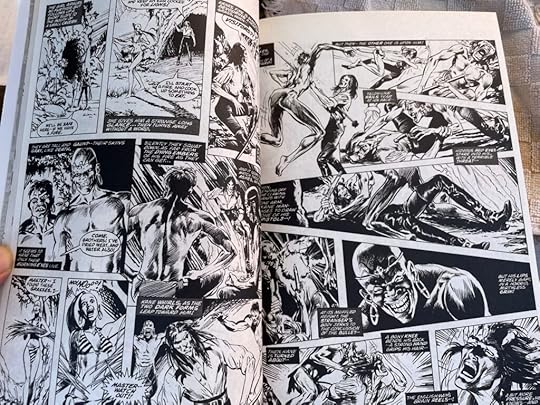
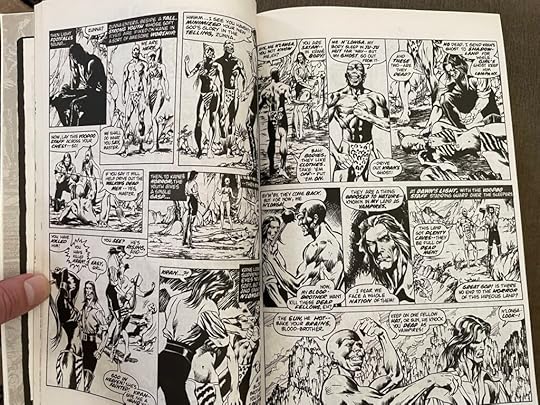
Steve Gan takes over for The Right Hand of Doom. Good work, though there is almost a touch of Mad Magazine about it. Still, hard to complain.

Mike Zeck draws The Silver Beast Beyond Torkertown. It is somewhat crude compared to the previous entries.
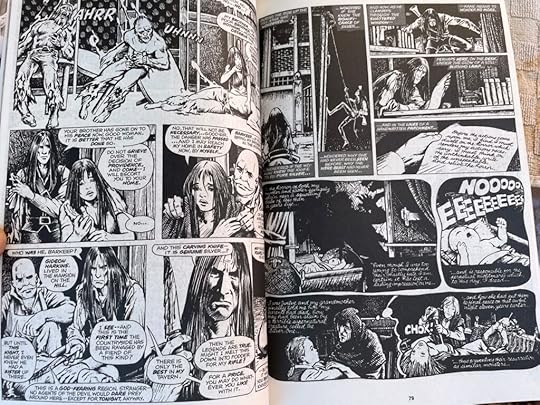
Howard Chaykin takes the art duties for Rattle of Bones, and we are treated to a step up from the B-team.

The positive trend continues with Castle of the Devil, by the duo of Alan Kupperberg and Sonny Trinidad. It is just sub-Conan, I think, but it’s a close call.
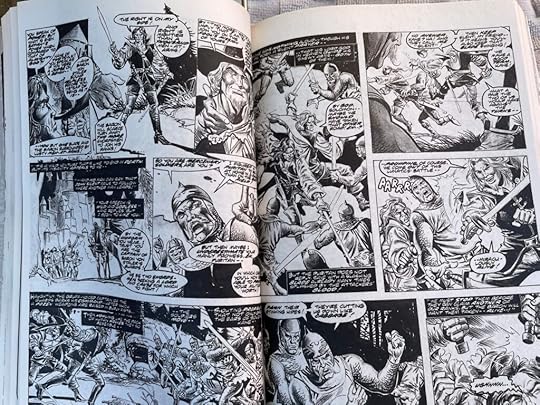
Next we get the first of two adaptations of Solomon Kane’s Homecoming. This one with art by Virgilio Redondo and Rudy Nebres. Nicely illustrative, I think, but there is something about the inking that is lacking.
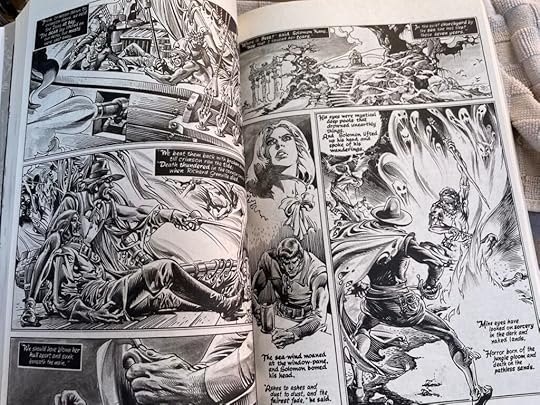
Sonny Trinidad handles the art solo for The Dragon at Castle Frankenstein. (I don’t know about this Dracula, Frankenstein, Wolfman vibe they were going for. But that’s not what I’m considering in this post.) I think this is excellent work, on par with his collaboration with Kupperberg.
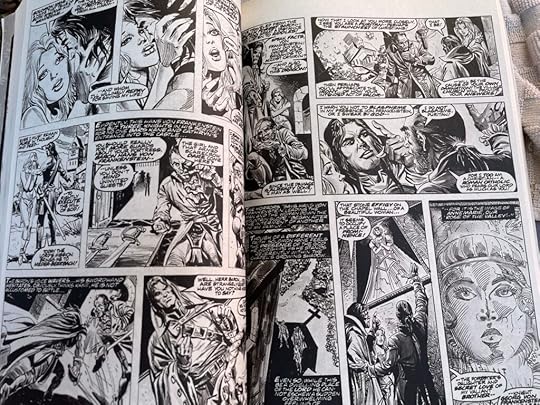
Steve Gan returns, inked by Dino Castrillo for The Cold Hands of Death. I don’t think the inking does Gan justice. Some panels are fine, others seem to lack depth.

We get a treat for the next several stories. David Wenzel, illustrator of The Hobbit comic adaptation, pencils. And he’s not bad. I think this is early work, and he definitely had room to improve. The inker shifted from story to story and you can see the difference in each. (The best is, I think, when Wenzel inked his own pencils.) Wenzel’s isn’t of the quality of Chaykin or Trinidad. But it is kinetic and suits Kane pretty well.
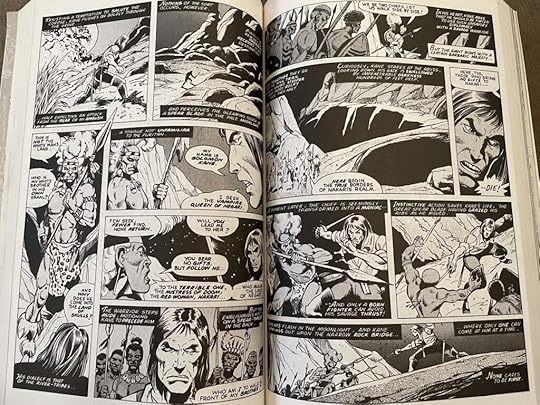
Steve Gan is back, inking Will Meugniot on The Footfalls Within. It hits the Savage Sword style pretty well and is consolation for Wenzel moving on. But don’t fear, Wenzel returns for the next three issues. And, on the whole, I think I preferred Meugniot and Gan. Though Wenzel’s Work on The One Black Stain is outstanding.

On Red Seas we have Danny Bulandi, an artist who I think would be better suited to color work rather than black and white. But it is decent.

Next we have Steve Carr, inked by the great Al Williamson, providing another adaptation of Solomon Kane’s Homecoming. A direct comparison is interesting. Both are worthwhile. I think I prefer the latter, drawn out, picture heavy version. Carr and Williamson return for the next couple of stories. Perhaps providing the best of Solomon Kane art: a hint of what the A-team might have brought to Solomon Kane.
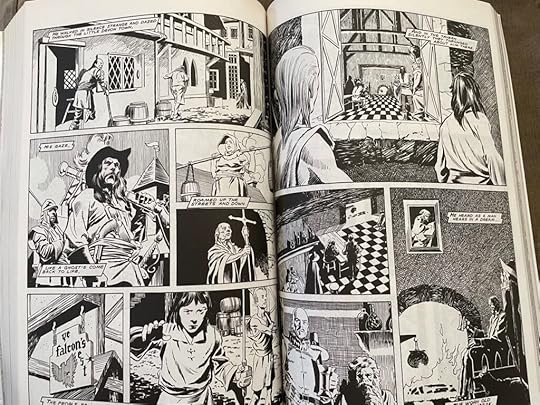
Colin MacNeil brings us to a conclusion, drawing a two part Conan/Solomon Kane crossover. The faces take some getting used to. The style isn’t classic Savage Sword. But it’s pretty good.

If you are, like me, an aficionado of the dour puritan, check out some of his illustrated adventures. Hit and miss, but overall worth your time.
And, if you are still taking my advice, here’s something else worth your time: Blood and Jade, book one of Semi-Autos and Sorcery, is still available for a ridiculously low price (digitally — print is more, of course.) And book two, Santa Anna’s Sword, is scheduled for publication in mere days following the writing of this post.
August 29, 2021
Not Precisely a Shindig
The Lizzi household threw a little party yesterday, with attendees primarily from the neighborhood. We wanted to celebrate. MBW passed the mortgage loan officer national exam (by all accounts a rather devilish test.) I’m proud of her. I remember all the work and stress that preceded and carried through the Bar Exam, so I could empathize with all she endured.
We also celebrated (somewhat belatedly) the publication of the first book of Semi-Autos and Sorcery, Blood and Jade. And I suppose I was also prematurely celebrating the release of book two, Santa Anna’s Sword, due out in just over a week from the writing of this post.

I vended a few books. Today’s grocery was shopping courtesy of those, um, patrons of the arts who partook of my homebrew and the pitchers of specialty margaritas MBW prepared. MBW has recently discovered the fun and limitless potentiality of margaritas. Taking advantage of the season we’ve picked buckets full of blackberries this month, so naturally one of her offerings was a blackberry margarita. I did have a sip, before resorting as usual to beer. It was good.

The HA had a marvelous time as most attendees brought children. I’m glad she enjoyed a last blowout before the commencement of school tomorrow. The HA is now a second grader. What, me feel old? Never.
August 22, 2021
Quiet Doings

The HA is spending a few days with her grandparents on the coast. Thus MBW and I have a childless weekend, unless you count the new kittens (which, soulless barbarian that I am, I don’t.) We planned to drive to Lost Lake, rent some kayaks, and paddle about with Mt. Hood in the background, casting its reflection upon the placid, mirror surface of the lake. The weather, however, had other plans.
I spent some time looking at local weather forecasts and found the nearest place with the lowest chance of precipitation and highest temperature. After considering the options, we drove northwest, crossing the Mighty Columbia, to spend a couple of hours strolling along the esplanade in Vancouver. (Washington, not B.C.)


The rain held off and the temperature remained clement. We clambered down to an artificial sand beach, threw some rocks into the river, viewed statuary, watched birds, sailboats, and fishermen.



And, always important, ate lunch at a riverfront restaurant.

The day wasn’t all self-indulgence, mind you. I did spend an hour working on book four of Semi-Autos and Sorcery. Getting close to the 45,000 word mark.Will there be a fourth book? Well, that’s rather up to the marketplace. If the sales of the first three indicate a demand, it seems likely. Book one, Blood and Jade, is out now if you want to take a look.



